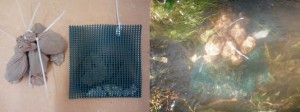In this post, Diego Fernández informs about their recent paper on in-stream effects of fungicides on litter decomposition.
Litter decomposition (LD) in streams is of central importance, as it represents the main source of energy in those streams were primary production is very limited (mainly low-order streams). Fungi are crucial for LD, as they are the main microbial decomposers and convert leaves into a more nutritious food resource for shredders. On the other hand, the fungicides that farmers apply to protect crops can enter the streams (mainly via run-off during precipitation events), where they have the potential to affect non-target aquatic fungi. This may propagate to effects on LD, but…to what extent?

Leaf bags used to assess microbial and invertebrate-mediated litter decomposition (photos by K. Voß)
Here we briefly present our recently published paper “Effects of fungicides on decomposer communities and litter decomposition in vineyard streams”. This is the second paper of a field study in 17 streams of the wine-growing area of Palatinate presenting different levels of pollution. To characterise fungicide toxicity, we monitored 19 organic pesticides (15 fungicides and 4 insecticides) during four rainfall events within the application period in 2012 using passive samplers and water sampling. The resulting chemical data was already published in Environmental Pollution, together with the analytical details. In this second paper, we present the effects of pesticide toxicity on several LD-related biological endpoints, which were monitored in autumn 2012 coinciding with the major leaf litter input into streams.
Fungicides accounted for more than 99% of the pesticide toxicity in polluted sites. Along the toxicity gradient we found changes in the structure of microbial and shredder communities, as well as a decrease in fungal biomass. We also detected up to 40% reduction in microbial LD rate in polluted streams. By contrast, neither the invertebrate LD rate nor gammarid feeding rates (gammarids dominate the shredder community in these streams) correlated with fungicide toxicity in the water, but both were negatively associated with sediment copper concentrations. A subsequent laboratory experiment employing field fungicide concentrations suggested that the microbial community changes are causal. Overall, our results suggest that fungicides can affect LD under field conditions.
The paper was published in Science of the Total Environment and authored by Diego Fernández, Katharina Voß, Jochen Zubrod, Mirco Bundschuh and Ralf Schäfer.
